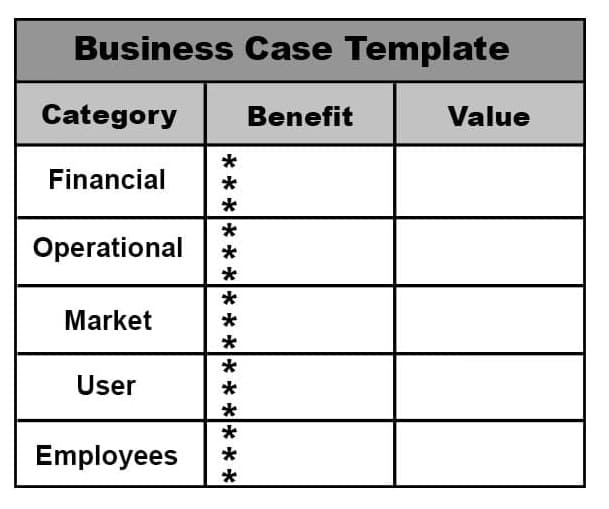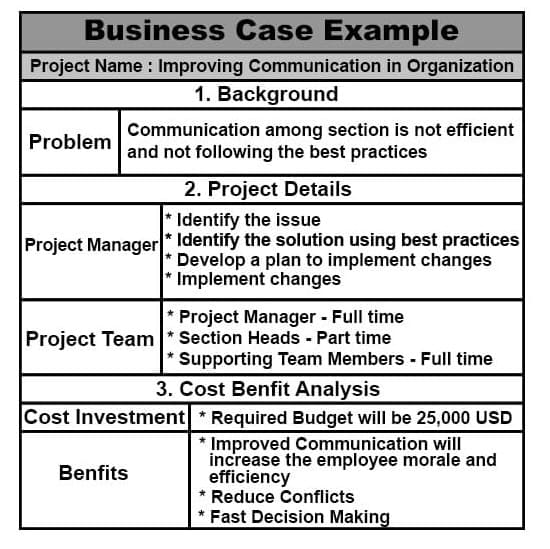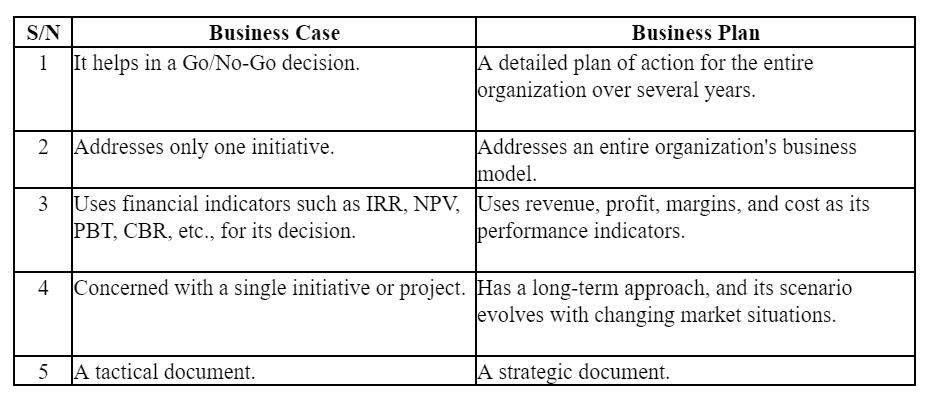Business Case: Definition, Example, and Template |
Projects have risks. Risks come in different forms, such as financial losses, reputation, market share, customer loyalty, etc. A business case can help reduce these risks.
Before initiating a project, organizations ensure the project is worth the investment of resources. A business case is a phase gate that determines whether a project will continue to the next phase, be terminated, or be modified.
Stakeholders measure the project’s success in terms of cost, scope, time, and delivering the intended value. A business case connects the project with its value or benefits.
Today’s blog post will discuss the business case and provides its example and a sample template.
Mục Lục
What is a Business Case? Definition & Meaning
Definition & Meaning: A business case documents economic feasibility to justify an initiative and is a basis for project initiation.
It includes the feasibility study and explains why the opportunity is worth pursuing. It provides the commercial viability, affordability, and achievability of the project.
New business ventures, product development, IT investments, innovation, etc., require investments, so business analysis weighs the investment against the value the project will deliver.
The value indicates project success and includes outcomes from the user’s perspective. It focuses on the outcome of the deliverables.
Many stakeholders cannot see the project’s value or opportunities and need a winning business case. A winning business case speaks in facts and style. Business executives must possess presentation skills to present business cases to stakeholders and win their trust.
Top management, the company board, or business analysts carry out the business case study. It is the WHY for the project.
In most cases, it happens after the Needs Analysis and Feasibility Study and before studying the Benefits Management Plan.

Benefit – Cost = Value (Tangible + Intangible)
The value becomes eroded if the benefit is at a higher cost. However, if the benefit outweighs the invested cost, the project is worth investing in.
The business case is an economic outcome of the feasibility study and helps management make a go or no-go decision.
Project managers do not participate in the business case studies; instead, they receive the project charter, which includes some business case elements.
However, they can request business case documents. This project document provides them with an understanding of the value of the project and the reasons for the project initiation.
Project managers can use business case studies as a source of inspiration to motivate the project team members.
The calculation of financial indicators is a significant part of the business case.
The calculation of financial indicators is a significant part of the business case.
- Internal Rate of Return (IRR): This is the interest you earn as an investor for ‘lending’ money to the project. Mathematically, you can calculate it by summing all present values over the project’s life to zero.

- Return on Investment (ROI): This compares the money earned (or lost) on investment to the invested amount.

- Net Present Value (NPV): This is the value of all future cash flows over the entire life of an investment discounted to the present.
- Payback Time (PBT): The minimum duration when the cash flow becomes positive. You measure it in months or years. It is one quick way of measuring profitability. In this case, shorter is better.
- Cost-Benefit Ratio (CBR): This is the ratio of investment cost to the estimated benefit (which has been monetized).
- Profitability Index (PI): This is the ratio of the present value of future cash flows to the investment cost.

Business Case Decision-Making Table

Content of a Business Case
A business case can include the following elements.
- Executive Summary: This shows the key points, particularly the project’s financial benefits. An executive summary should be clear, credible, and persuasive. Many stakeholders prefer to read the summary first; therefore, it must be convincing.
- Introduction: This provides a brief background of the company’s strategic goal and mission, highlighting how the project aligns with the organization’s objectives.
- Scope: This defines the project boundaries. This is the high-level scope and captures the proposed business solution. For example, for a procurement project, it will capture the freight, commissioning and installation, training, spares, etc.
- Business Need: This is a statement of the problem to solve. It can be a need that is ill-met, unarticulated, or unmet. Thus, it is an opportunity for the organization to create value.
- Alternatives: This shows an alternative analysis and how the proposed solution is the preferred way to proceed. Presenting alternatives further supports justification.
- Benefits: This states the value proposition. A value proposition describes the unique benefit that the idea brings to the company. It could be revenue, cost savings, or non-economic (e.g., regulatory compliance). It states the strengths associated with the offering and how it aligns with the corporate strategy.
- Cost: This highlights the funding requirements. It can include the bill of quantity, a proforma invoice, etc.
- Financial Analysis: This expresses the cash flow expected or projected from the investment, then calculates financial indices such as IRR, NPV, PBT, and NCR, as explained earlier. Use figures and charts to communicate your investment viability, as shown below.
- Conclusion: Here, a final appeal is expressed for approval of the business case.
How to Write a Business Case
A business case is a key to the project’s success and the basis of the project charter and project management plans. Writing a business case requires experience, industry and market knowledge, and authority to initiate the project.
The following four steps are required to write a business case:
#1. Identify the Problem
Businesses initiate to solve a problem. Every project has a goal and objective that aligns with the organizational objective. For example, businesses can create a project to create a new product, build a new factory, conduct market research, etc.
#2. Identify Multiple Solutions
A problem can have many solutions, and you must find the best solution. Therefore, identify multiple solutions for the problem and then analyze the best solution. Then, you can prioritize them using some parameters, e.g., the feasibility of the resolution, cost, duration, required skills, etc.
#3. Suggest the Recommended Solution
Now you have multiple prioritized solutions. You will further build the case for the best-recommended solution and send it to the management for their final decision.
#4. Explain the Implementation Approach
This is the last step, and here you explain to stakeholders how you will implement the solution to achieve the organizational goal. You will also explain how the project will benefit the organization.
Keep the following point in your mind while writing a business case:
- Keep it short and simple and include essential information
- Do not use jargon, idioms, and phrases
- Explain the vision
- Show the project benefit
- Ensure the business case is clear, interesting, and concise
Business Case Sample Template
The below image shows a business case sample template.
 Business Case Template
Business Case Template
Business Case Example
The below image shows a business case example using a different template.
 Business Case Example
Business Case Example
Differences Between a Business Case and Business Plan
Many professionals are often confused between the business case and business plan, though the difference is clear.
The following table shows the difference between the business case and the business plan.

Similarities Between a Business Case and Business Plan
- Both examine an opportunity
- Both consider financial analysis
- Both are used in decision-making
- Both investigate the future, complement each other, and are business documents.
Business Case Vs Executive Summary
An executive summary is the summary of a document. In project management, executing summary is the summary of all project management documents that stakeholders can read and understand quickly by going through them deeply.
The executive summary provides high-level key information about the document. In addition, the business case will also have a short executing summary for stakeholders to have a quick glance at the business case.
Business Case Vs Project Charter
A project charter is an official document that initiates the project assigns the project manager, and gives them authority and resources to complete the project.
The project charter includes high-level project information such as project objective, project description, executive summary of the business case, project duration, project budget, name of key stakeholders, high-level risks, key assumptions, and constraints.
Benefits of a Business Case
- It explains the benefits of a business idea.
- It is a tool used to convince stakeholders of the value of a business idea.
- It provides details on how a project will benefit an organization.
- It helps organizations make better investment decisions
Do You Always Need a Business Case?
Not all project requires a business. For example, if the problem is known and the solution is available, you do not need a detailed business case. In such a situation, you can have a simple business case, or you may not have one at all.
You will need a business case when the problem is unique, or you are handling it for the first time, and the solution is not clearly visible.
Business cases provide all clarification that stakeholders need to decide whether to initiate the project.
Frequently Asked Questions
#1. Who Creates the Business Case?
The project sponsor, top management, or business analyst creates the business case. However, they can take help from the project sponsor if required.
#2. When is the Business Case Developed?
The business case is developed before the project is approved and the charter is signed.
Summary
A business case is key to every project, as it establishes the justification for the project. It is a vital project document that aligns activities to their value and ensures the organization’s resources become invested in the right project.
References















![Toni Kroos là ai? [ sự thật về tiểu sử đầy đủ Toni Kroos ]](https://evbn.org/wp-content/uploads/New-Project-6635-1671934592.jpg)


